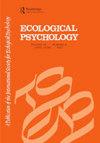Perceptual-Motor Regulations and Visual Exploration Strategies Allowing Older Drivers to Intercept a Moving Inter-Vehicular Gap
IF 1.7
3区 心理学
Q3 PSYCHOLOGY, EXPERIMENTAL
引用次数: 1
Abstract
Abstract The aim of this study was to characterize the behavior of older people when intercepting a moving gap, with reference to that produced by younger people. Participants were asked to intercept a moving inter-vehicular space within a train of vehicles, by modulating their speed if necessary. Five initial distances to the interception location were manipulated (Offset), without the knowledge of the participants, requiring distinct speed regulations. The analyses focused on displacements kinematics as well as on the associated visual information taking strategies. The results indicate several similarities in the behaviors produced by two populations. Functional speed regulations are initiated early and persist until the interception. These regulations allow for safe interception. The visual strategies deployed by the older participants are also relatively close to those of the younger participants, with the main areas of interest located on the vehicles located upstream of the interval. The results also reveal differences between the two populations. The regulations produced by older drivers are initiated late in negative Offset giving rise to some extent to unsafe behavior. These results are discussed in relation to the decrease in motion detection thresholds with age. Our dataset could be particularly useful in view of the design of driver assistance systems for older drivers.允许老年驾驶员拦截移动中的车间距的感知运动规则和视觉探索策略
摘要本研究的目的是参考年轻人产生的差距,描述老年人在拦截移动差距时的行为。参与者被要求在必要时通过调节速度来拦截一列车辆内移动的车间空间。在参与者不知情的情况下,操纵了到拦截位置的五个初始距离(偏移),需要不同的速度规定。分析的重点是位移运动学以及相关的视觉信息获取策略。结果表明,两个群体的行为有几个相似之处。功能性速度调节很早就开始了,并一直持续到拦截。这些规定允许安全拦截。年长参与者采用的视觉策略也与年轻参与者相对接近,主要感兴趣的区域位于区间上游的车辆上。研究结果还揭示了两个种群之间的差异。老司机制定的法规是在负补偿中较晚启动的,在一定程度上会导致不安全行为。这些结果与运动检测阈值随年龄的减小有关地进行了讨论。鉴于为老年驾驶员设计驾驶员辅助系统,我们的数据集可能特别有用。
本文章由计算机程序翻译,如有差异,请以英文原文为准。
求助全文
约1分钟内获得全文
求助全文
来源期刊

Ecological Psychology
PSYCHOLOGY, EXPERIMENTAL-
CiteScore
3.30
自引率
10.50%
发文量
8
期刊介绍:
This unique journal publishes original articles that contribute to the understanding of psychological and behavioral processes as they occur within the ecological constraints of animal-environment systems. It focuses on problems of perception, action, cognition, communication, learning, development, and evolution in all species, to the extent that those problems derive from a consideration of whole animal-environment systems, rather than animals or their environments in isolation from each other. Significant contributions may come from such diverse fields as human experimental psychology, developmental/social psychology, animal behavior, human factors, fine arts, communication, computer science, philosophy, physical education and therapy, speech and hearing, and vision research.
 求助内容:
求助内容: 应助结果提醒方式:
应助结果提醒方式:


